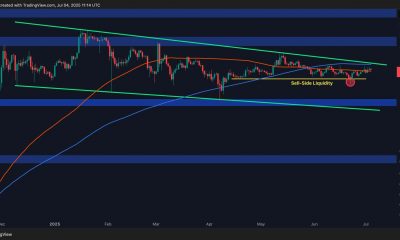Commodities
Oil posts weekly loss as interest rate policy spurs fuel demand worries

By Arathy Somasekhar
HOUSTON (Reuters) -Oil prices rose about 1% on Friday, but fell for the week on worries that strong U.S. economic data would keep interest rates elevated for a longer period, curbing fuel demand.
The July contract rose 76 cents to $82.12 a barrel. The more-active August contract closed up 73 cents at $81.84.
U.S. West Texas Intermediate (WTI) crude futures settled 85 cents, or 1.1%, higher to $77.72.
On Thursday, Brent closed at its weakest since Feb. 7 and U.S. WTI futures at their lowest since Feb. 23.
Summer demand in the United States is expected to pick up starting this weekend, and some investors are wondering if the selloff was exaggerated, said Dennis Kissler, senior vice president of trading at BOK Financial.
Brent closed down 2.1% for the week. It declined for four straight sessions this week, its longest losing streak since Jan 2. WTI settled down 2.8% for the week.
Worries over Federal Reserve interest rate policy and last week’s bump in US crude oil inventories weighed on market sentiment, said Tim Evans, an independent energy analyst.
Minutes of the Fed’s latest policy meeting released on Wednesday showed policymakers questioning whether interest rates were high enough to tame stubborn inflation. Some officials were willing to raise borrowing costs again if inflation surged.
Fed Chair Jerome Powell and other policymakers have since said they feel further increases are unlikely.
Higher interest rates increase the cost of borrowing, which can slow economic activity and dampen demand for oil.
Consumer sentiment also fell to a five-month low on mounting fears about borrowing costs staying high. At face value, pessimism among households would imply slower consumer spending, though the relationship between the two has been weak.
Oil demand is still robust from a broader perspective, analysts at Morgan Stanley wrote in a note, adding they expect total oil liquids consumption to increase by about 1.5 million barrels per day this year.
Soft U.S. gasoline demand has been offset by global demand, which surprised to the upside, especially in the early parts of the year, the analysts said.
U.S. gasoline product supplied, a proxy for demand, reached its highest level since November in the week to May 17, the Energy Information Administration (EIA) said on Wednesday.
On the supply side, the oil rig count, an early indicator of future output, was unchanged at 497 this week, energy services firm Baker Hughes said.
Meanwhile, the market is awaiting a June 2 online meeting of the OPEC+ producer group comprising the Organization of the Petroleum Exporting Countries and its allies to discuss whether to extend voluntary oil output cuts of 2.2 million barrels per day.
Analysts largely anticipate that current production cuts will be extended at least to the end of September.
Russia, in a rare admission of oil overproduction, said this week it exceeded its OPEC+ production quota in April for “technical reasons,” a surprise that analysts and industry sources say shows Moscow’s challenges in curbing output.

Venezuela aims to produce 1.23 million barrels per day (bpd) of oil in December, adding about 290,000 bpd compared to the start of the year, following the addition of drilling rigs, oil minister Pedro Tellechea said.
Money managers raised their net long futures and options positions in the week to May 21, the U.S. Commodity Futures Trading Commission (CFTC) said on Friday.
Commodities
Oil prices rise; U.S. crude inventories plunge, Russia-Ukraine truce eyed
Commodities
India’s Reliance to stop buying Venezuelan oil over US tariffs, sources say
Commodities
Oil prices climb on Venezuela supply worries

 Forex3 years ago
Forex3 years agoForex Today: the dollar is gaining strength amid gloomy sentiment at the start of the Fed’s week

 Forex3 years ago
Forex3 years agoUnbiased review of Pocket Option broker

 Forex3 years ago
Forex3 years agoDollar to pound sterling exchange rate today: Pound plummeted to its lowest since 1985

 Forex3 years ago
Forex3 years agoHow is the Australian dollar doing today?

 Cryptocurrency3 years ago
Cryptocurrency3 years agoWhat happened in the crypto market – current events today

 World3 years ago
World3 years agoWhy are modern video games an art form?

 Commodities3 years ago
Commodities3 years agoCopper continues to fall in price on expectations of lower demand in China

 Economy3 years ago
Economy3 years agoCrude oil tankers double in price due to EU anti-Russian sanctions































